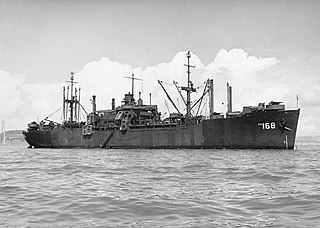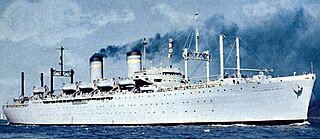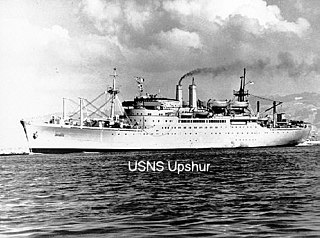
The United States Navy maintains a number of its ships as part of a reserve fleet, often called the "Mothball Fleet". While the details of the maintenance activity have changed several times, the basics are constant: keep the ships afloat and sufficiently working as to be reactivated quickly in an emergency.

USS Admiral W. S. Sims (AP-127) was a transport in the United States Navy. She was later renamed USNS General William O. Darby (T-AP-127). Later her name was struck and she was known simply by her hull number. In 1981, she was reclassified as IX-510.

USS Gage (APA-168) was a Haskell-class attack transport in service with the United States Navy from 1944 to 1947. Gage was the sole remaining example of the 117-ship Haskell-class and was scrapped in 2009.

USS General J. H. McRae (AP-149) was a General G. O. Squier-class transport ship built for the United States Maritime Commission during World War II. In 1946 she was transferred to the US Army and operated as USAT General J. H. McRae. On 1 March 1950 she was transferred to Military Sea Transportation Service and operated as USNS General J. H. McRae (T-AP-149). She was named for US Army Major General James H. McRae.
USTS Empire State VI (T-AP-1001), callsign KKFW, IMO number 5264510, was a troop ship of the United States Navy and training vessel of the United States Maritime Service.

USS LST-849 was an LST-542-class tank landing ship in the United States Navy during World War II. Late in her U.S. Navy career, she was renamed Johnson County (LST-849)—after counties in Arkansas, Georgia, Illinois, Indiana, Iowa, Kansas, Kentucky, Missouri, Nebraska, Tennessee, Texas, and Wyoming—but never saw active service under that name.

USS Pinnebog (AOG–58) was a Patapsco-class gasoline tanker acquired by the U.S. Navy for the dangerous task of transporting gasoline to warships in the fleet, and to remote Navy stations.

USS Gallatin (APA-169/LKA-169) was a Haskell-class attack transport acquired by the U.S. Navy during World War II for the task of transporting troops to and from combat areas.

USS General H. F. Hodges (AP-144) was a General G. O. Squier-class transport ship for the U.S. Navy in World War II. The ship was crewed by the U.S. Coast Guard until decommissioning. She was named in honor of U.S. Army general Harry Foote Hodges. She was transferred to the U.S. Army as USAT General H. F. Hodges in 1946. On 1 March 1950 she was transferred to the Military Sea Transportation Service (MSTS) as USNS General H. F. Hodges (T-AP-144). She was later sold for commercial operation under the name SS James, before being scrapped in 1979.

USS Cape Cod (AD-43) was the third Yellowstone-class destroyer tender in the United States Navy.

USNS Henry Gibbins (T-AP-183) was a troop transport that served with the United States Military Sea Transportation Service (MSTS) during the 1950s. Prior to her MSTS service, she served as US Army transport USAT Henry Gibbins during World War II. She later served with the New York Maritime Academy as TS Empire State IV and with the Massachusetts Maritime Academy as USTS Bay State.

USNS Sgt. Sylvester Antolak (AP-192/T-AP-192) was a Boulder Victory-class cargo ship that served as a United States Army Transport, and in the United States Navy's Military Sea Transportation Service, in the post-World War II period.

The Type C4-class ship were the largest cargo ships built by the United States Maritime Commission (MARCOM) during World War II. The design was originally developed for the American-Hawaiian Lines in 1941, but in late 1941 the plans were taken over by the MARCOM.

USS Admiral R. E. Coontz (AP-122) was an Admiral W. S. Benson-class transport built for the U.S. Navy during World War II. She was laid down under a Maritime Commission contract on 15 January 1943 at Alameda, California, by the Bethlehem Steel Corp., and launched on 22 April 1944. She was sponsored by Mrs. Edwin Kokko, daughter of Admiral Coontz, and commissioned on 21 November 1944.

SS Cape Intrepid was originally laid down in 1975 as SS Arizona a Type C7 ship intended for both commercial or military use. The ship was launched in 1975 and turned over to the Maritime Administration for commercial use and acquired by the Lykes Brothers and named the SS Lipscomb Lykes. On June 8th 1976 she was removed from commercial duty and reacquired by the United States Navy and renamed USNS Jupiter to serve alongside USNS Mercury. On 8 June 1976 she was transferred to Military Sealift Command, and renamed the SS Cape Intrepid. Since then the ship has been active in transport roles including a long term attachment to the 833rd transport regiment. She is currently in reserve status and can be activated if called upon in 5 days as part of the ready reserve fleet. The ship is currently moored in Tacoma, Washington.

USTS Patriot State, IMO number 5422409, formerly Santa Mercedes, was a training vessel of the United States Maritime Service. Originally build as a cargo/passenger liner for the Grace Line, it was later converted to a training vessel for the Massachusetts Maritime Academy.

USNS Upshur (T-AP-198), was a Barrett Class transport named in honor of Major General William P. Upshur, USMC.
USS Herald of the Morning was a C2-S-B1 Maritime Commission hull that served in heavy combat in the Pacific Theatre during World War II as a merchant and United States Navy vessel.

Atlantic Reserve Fleet, Norfolk was a part of the United States Navy reserve fleets, also called a mothball fleet, and was used to store the many surplus ships after World War II. The Atlantic Reserve Fleet was just south of the Norfolk Naval Shipyard, called the South Gate Annex in Portsmouth, Virginia, 2 mi (3.2 km) south of Norfolk, Virginia. The reserve fleet was stored in the freshwater of the Elizabeth River, Southern Branch near the Jordan Bridge. The freshwater was good for long-term storage for ships. Some ships in the fleet were reactivated for the Korean War and Vietnam War.

















